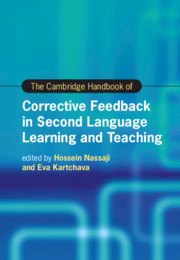Book contents
- The Cambridge Handbook of Corrective Feedback in Second Language Learning and Teaching
- Cambridge Handbooks in Language and Linguistics
- The Cambridge Handbook of Corrective Feedback in Second Language Learning and Teaching
- Copyright page
- Contents
- Figures
- Tables
- Contributors
- Acknowledgments
- Introduction Corrective Feedback in Second Language Teaching and Learning
- Part I Theoretical Perspectives on Corrective Feedback
- Part II Methodological Approaches in the Study of Corrective Feedback
- Part III Different Delivery Modes of Corrective Feedback
- 9 Oral Corrective Feedback
- 10 Written Corrective Feedback
- 11 Technology-Mediated Corrective Feedback
- 12 Gestures, Corrective Feedback, and Second Language Development
- Part IV Feedback Provider, Feedback Intensity, and Feedback Timing
- Part V Corrective Feedback and Language Skills
- Part VI Contexts of Corrective Feedback and Their Effects
- Part VII Learners’ and Teachers’ Feedback Perspectives, Perceptions, and Preferences
- Part VIII Individual Differences, Tasks, and Other Language- and Learner-Related Factors
- Index
- References
12 - Gestures, Corrective Feedback, and Second Language Development
from Part III - Different Delivery Modes of Corrective Feedback
Published online by Cambridge University Press: 26 February 2021
- The Cambridge Handbook of Corrective Feedback in Second Language Learning and Teaching
- Cambridge Handbooks in Language and Linguistics
- The Cambridge Handbook of Corrective Feedback in Second Language Learning and Teaching
- Copyright page
- Contents
- Figures
- Tables
- Contributors
- Acknowledgments
- Introduction Corrective Feedback in Second Language Teaching and Learning
- Part I Theoretical Perspectives on Corrective Feedback
- Part II Methodological Approaches in the Study of Corrective Feedback
- Part III Different Delivery Modes of Corrective Feedback
- 9 Oral Corrective Feedback
- 10 Written Corrective Feedback
- 11 Technology-Mediated Corrective Feedback
- 12 Gestures, Corrective Feedback, and Second Language Development
- Part IV Feedback Provider, Feedback Intensity, and Feedback Timing
- Part V Corrective Feedback and Language Skills
- Part VI Contexts of Corrective Feedback and Their Effects
- Part VII Learners’ and Teachers’ Feedback Perspectives, Perceptions, and Preferences
- Part VIII Individual Differences, Tasks, and Other Language- and Learner-Related Factors
- Index
- References
Summary
This chapter examines the role of nonverbal feedback, particularly gestures. It reviews and evaluates the findings of current research in this area and offers suggestions for future research. The chapter begins by discussing how gestures are used in a language classroom followed by an examination of their effectiveness in the development of different language skills including vocabulary, pronunciation, grammar, and comprehension. The relationship between learners’ individual differences, gestures, and corrective feedback is also addressed.
Keywords
- Type
- Chapter
- Information
- The Cambridge Handbook of Corrective Feedback in Second Language Learning and Teaching , pp. 251 - 272Publisher: Cambridge University PressPrint publication year: 2021
References
- 1
- Cited by

